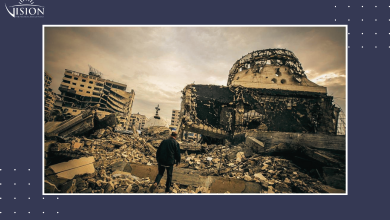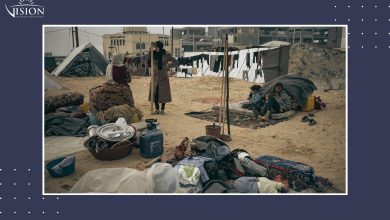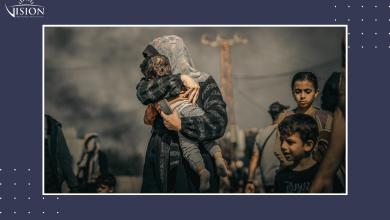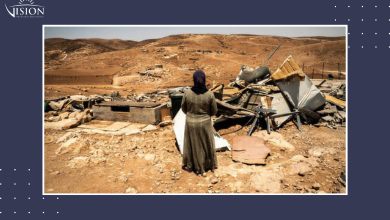Solidarity Movements with Palestine, History, Impact, and Future
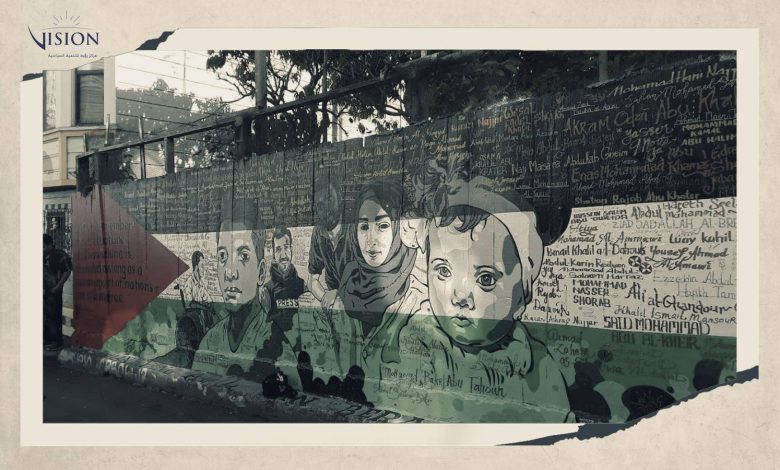
An interview with Dr. Rabab Abdulhadi, Interviewed By Dr. Hasan Obeid
In the aftermath of October 7th last year, a significant mobilization of global solidarity with the Palestinian peopleunfolded, in which the Palestinian resistance is engaged in the pivotal struggle of the Al-Aqsa Flood against the Zionist occupation. Recognizing the critical import of such solidarity, the Vision Center for Political Development convened with Dr. Rabab Abdulhadi, a distinguished figure among intellectuals and activists committed to the Palestinian cause. Dr. Abdulhadi, an expert in ethnic, colonial, and resistance studies within the United States, has contributed profoundly through her academic tenure at prestigious institutions such as the University of Michigan, Yale, and the University of San Francisco. Facing over fifteen years of Zionist and racist endeavors aimed at discrediting her, including violence threats and baseless legal actions (including federal court) intended to disrupt her professional journey, Dr. Abdulhadi emerged victorious against such adversities, steadfastly advancing her educational mission on Palestine. Her scholarly output includes an extensive array of publications on solidarity, anti-racism, feminist movements, and more, marking her as a pivotal voice in these discourses.
Dr. Abdulhadi’s seminal role in the formation of the Committee for Solidarity with Palestine, alongside her involvement in numerous solidarity committees and events in the United States, prompted the Vision Center to engage her in an interview. This initiative sought to delve into the intricacies of international solidarity movements with Palestine, exploring their genesis, evolution, with higher focus on post-October 7th. Through a series of meticulously crafted inquiries, the discussion aimed to dissect the historical backdrop, influence, and prospective trajectory of these movements, offering a nuanced exploration of their dynamics and potential.
In essence, how might one articulate the concept of solidarity movements with Palestine?
The solidarity movement with Palestine constitutes an indivisible segment of the global solidarity movement, encompassing a spectrum of social movements championed by oppressed individuals across various global locales. This includes movements dedicated to peace and justice, Black rights, labor and women’s rights, and the rights of marginalized, oppressed, and colonized groups worldwide.
Solidarity represents a dialectical process of interconnectedness; it supports colonized peoples in their struggles against colonization, oppression, racism, and persecution on one hand, and on the other, it unites to achieve their freedom. Thus, solidarity movements do not merely call for the resolution of conflicts but align with the oppressed party in the struggle.
The compositions and principles vary from one group to another, with these principles shaping the discourse of solidarity with Palestine based on the geographical context of these groups, their connection to the Palestinian cause, and the historical experiences of struggle these peoples have undergone. These differences in the mechanisms and extent of solidarity with Palestine can be discerned among Arab and Islamic populations, Third World countries, and Western societies.
What are the historical roots of the solidarity movements with Palestine, and what are the major transformations they have undergone?
In modern history, the concept of solidarity emerged prominently in the 19th century through labor solidarity movements, significantly influenced by the philosophy of Karl Marx. Over time, solidarity evolved into a global movement under the ethos of “An injury to one is an injury to all,” primarily within the labor sector across different locations. Another communist leader, Vladimir Lenin, spoke on the freedom of peoples to determine their own destiny, advocating for the independence of colonized peoples and their right to self-defense, suggesting that solidarity movements should extend beyond just the labor movement.
The origins of the Palestine solidarity movement trace back to the Baku Congress of 1920, convened by the Soviet Communist Party and incorporating diverse leftist and labor groups worldwide.
This solidarity movement encountered challenges with the rise of the Zionist labor force, which utilized the narrative of international worker solidarity while simultaneously contributing to the colonization of Palestine. This resulted in two distinct labor groups within Palestine: the Palestinians themselves, striving for liberation from foreign occupiers, and the Zionist Jewish workers who participated in the occupation.
During the Spanish Civil War, from July 18, 1936, to April 1939, numerous Palestinians fought alongside the Spanish people against Francisco Franco’s dictatorship. This participation bolstered solidarity with the Palestinian people in Spain, though the Zionist movement managed to disrupt this solidarity at the time.
Sheikh Izz ad-Din al-Qassam is one of the most notable figures in Palestinian solidarity, having come from Syria to lead guerrilla warfare against Israel, an endeavor that somewhat mirrors the contemporary situation in Gaza with armed group warfare.
Numerous solidarity movements emerged in Africa, Asia, and Latin America, particularly amidst the oppressed and suppressed peoples, especially with the rise of national liberation movements in Asia and Africa, followed by Latin America. This contributed to the unity of colonized peoples’ struggle against British and French colonizers, wherePalestine was under British colonial rule. The momentum for solidarity with Palestine increased after the Nakba in 1948.
Global support for the Palestinian cause continued over the subsequent years, notably at the Non-Aligned Movement conferences, established in 1955 in Bandung, Indonesia, which addressed the Palestinian issue, especially since Egyptian President Jamal Abdel Nasser was one of its leading figures. It is also pertinent to mention Che Guevara, one of the leaders of the global revolution, who visited the Gaza Strip in 1959 in support of the Palestinian people, just months after the triumph of the Cuban Revolution that shook the Americas and continues to be a thorn in the side of American imperialism.
During the same period, the Palestine Liberation Organization and the General Union of Palestinian Students emerged, playing a fundamental role in raising awareness among Palestinian students in political and guerrilla activities, developing solidarity movements with Palestine. The General Union of Palestinian Women played a role, though not at the same level of the students.
China played a significant role in training Palestinian fighters, supporting Palestinian peasants according to its Marxist vision and the nature of its agrarian society, which brought the Chinese closer to Palestine and somewhat opposed to Zionism. Before the Soviet Union decided to recognize the Palestinian resistance and provide it with weapons and training.
In the United States, the American activist Malcolm X fought against racism, championed Black rights, opposed the Zionist movement, and supported Palestinians. Additionally, the Black Panther Movement in America, with its spiritual father Robert F. Williams, who rejected Zionism and supported Palestine, significantly emerged during the 1960s alongside the rise of the Palestinian national liberation movement.
It’s noteworthy that Malcolm X and Robert Williams were not the only African Americans supporting the Palestinian struggle; we must not forget the group of Black intellectuals, activists, and academics who issued one of the first statements in solidarity with the Palestinian struggle, published in The New York Times on November 1, 1970. This statement clearly linked the liberation of Palestine with the decolonization of Africa and the liberation of Black people in America from the legacies of slavery and colonialism. The role of the international boxer Muhammad Ali also stands out, who, influenced by his conversion to Islam and his relationship with Malcolm X, refused military service in Vietnam, symbolizing the rise of the American anti-war movement against the Vietnam War.
Some Western countries opposed the Palestinian cause under the pretext of rejecting communism, portraying communism as a monstrous entity aiming to devour them. They perceived the Palestinian resistance as a front for socialist states, especially the Soviet Union, as if the Palestinian people lacked a legitimate cause or rationality, and were merely puppets manipulated by the Soviets, similar to how Zionist and Western colonial media claim that Hamas and other Palestinian resistance factions operate solely under Iran’s command.
After 1967, the situation changed drastically due to developments on the Palestinian scene, which clarified the contours of the solidarity movement. African Americans and the Vietnamese people declared their solidarity with Palestine, as did peoples supporting liberation movements in Vietnam and Cuba, becoming part of the alliance with the Palestinian people. This narrative remains obscured in the history of American movements in the 1960s, necessitating a reexamination of those narratives related to Palestine and resisting Zionist and colonial narratives attempting to erase them. The central role of the Vietnamese people in declaring solidarity with Palestine, along with peoples supporting liberation movements in Vietnam and Cuba joining forces with the Palestinian people, must be emphasized here.
In Algeria, Palestinians and Algerians mutually supported each other during the Algerian War of Independence. For instance, my primary school in Nablus was named after the Algerian activist Jamila Bouhired, and we sang the Algerian national anthem in our schools during that period.
This deepened with Palestinian activities as revolutionary resistance movements, as many other peoples helped and trained the Palestinians, from Iran, Lebanon, Guatemala, and other oppressed nations around the world.
Islamic countries were not isolated from solidarity with Palestine during this period, contrary to what some narratives suggest. Prime examples include the African Unity Conference, the Non-Aligned Movement, the Organization of Islamic Cooperation, and other Islamic organizations, or those including Islamic countries, which supported the Palestinian people in their struggle.
Solidarity movements organize themselves through two distinct forms: the first entails a hierarchical organizational structure with central leadership, either within a single country or transcending national boundaries, branching into committees each dedicated to specific, clear tasks within various local or international geographies. Often, these structures take the form of coalitions, such as the November 29 Alliance, initiated to organize the world’s largest solidarity march for Palestine on November 29, 1981. This coalition encompassed over a hundred liberation organizations and movements from Vietnam, El Salvador, Nicaragua, Haiti, the African National Congress, Patrice Lumumba’s followers, Black, Puerto Rican, Cuban, Korean movements, and Jews opposed to Zionism, among many other solidarity movements. This alliance was a one-time assembly, and I remember participating in this march.
Following the 1982 invasion of Lebanon, Lebanese and Palestinians revitalized this movement in support of the Lebanese and Palestinian peoples and in opposition to the invasion, leading every solidarity movement against the bombing and invasion of Beirut. However, the Palestinian solidarity movement at that time could not assert itself among other protest movements, such as the American peace movement, which organized a demonstration attended by a million people in New York City’s largest public park on June 12, 1982, against nuclear armament. Despite this, the organizers refused to allow Palestinian or Lebanese speakers, even as Beirut suffered brutal Zionist bombardment and despite all leadership parties of this peace coalition being aware of Israel’s nuclear armament program. Their allegiance to Zionism, and the legacy of McCarthyism, drove them insistently to silence Arab voices. Professor Noam Chomsky, the renowned linguist at MIT, refused to participate under these conditions and publicly criticized them.
The November 29 Alliance became the leader of all solidarity movements against the bombing and invasion of Beirut. During this period, other organizations and movements emerged, such as Jews Against the Israeli Massacre in Lebanon (JAIMIL), founded by activists Ariel Salzman, Gail Lerner, Professor Stuart Shaar, a comrade of Mehdi Ben Barka, and Norman Finkelstein. One of their notable actions was a sit-in inside the Israeli mission to the United Nations in New York.
In 1983, the alliance’s name was changed to the Committee for Solidarity with the Palestinian People, which continued its activities until the signing of the Oslo Accords in 1994. It transformed organizationally from a coalition of various organizations to a single entity with regular membership, unified leadership, and branches engaging in diverse activities, such as marches of tears, university events, alliances with churches and Jews opposed to Zionism, indigenous peoples, Black communities, and other groups. One of the major campaigns we conducted was “Israel and South Africa: The Apartheid Connection?” in 1985, in collaboration with the African National Congress (ANC).
The second form of organization within solidarity movements is characterized by horizontal leadership with an anarchistic perspective, akin to the “Global Solidarity Movement,” which operated without a clear leadership structure. Instead, participants engaged in roles driven by personal desire and their own perception of their roles. This movement lent its support to the Palestinian people during both the First and Second Intifadas and included activists such as the American Rachel Corrie, who was killed by the occupation forces in the Gaza Strip in 2003.
Most solidarity movements with Palestine principally rely on local support and donations for their funding, a reality that sometimes impacts the nature of their operations due to limited resources. This stands in contrast to the unrestricted financing of groups supporting the Zionist movement or other movements that equate Palestinians with Zionists, thereby compromising their independence in decision-making.
We have witnessed a development and momentum in global solidarity movements post-October 7th. Where do these movements operate, and how can this be interpreted?
The significant momentum of solidarity with Palestine during the Al-Aqsa Intifada cannot be understood in isolation from the context of prolonged efforts over seventy-six years, which have cumulatively contributed to enhancing the effectiveness and impact of the Palestine solidarity movement globally.
The 2014 conflict marked a pivotal point in the revival of the solidarity movement, especially with the prolonged resilience of the resistance and the Israeli massacres committed against Palestinians. Consequently, the world stood in support of Palestine during the conflict.
There were alliances with movements rejecting Islamophobia and racism, in addition to other groups fighting for their rights and the rights of the oppressed worldwide. The Palestine solidarity movement managed to mobilize all these groups in support of Palestine, contributing to the emergence of a strong solidarity movement post-October 7th.
Social media played a role in spreading videos and clips that illustrate the situation on the ground without censorship, thereby overcoming the challenge of biased or ideologically driven Western media. This enabled the clear truth to be conveyed to viewers everywhere in the world, mobilizing free peoples towards solidarity with the Palestinian people, especially in the Gaza Strip.
The emergence of Hamas as a key player in the First Intifada and its significant role in the Second Intifada introduced political and ideological pluralism to the Palestinian political arena, which was no longer limited to Fatah and leftist movements but now included the Islamic resistance movement. This encouraged many Muslims worldwide to participate and organize within a broad solidarity movement with Palestine.
The emergence of the BDS movement after its establishment in 2005, and its global role in boycotting Israel and everything supporting, financing, and sponsoring it worldwide, has bolstered the solidarity movement globally. This movement now possesses economic power that could compel some companies and institutions to cease supporting Israel, thereby strengthening the solidarity movement.
These cumulative developments set the stage for the aftermath of October 7th, when many Palestinian and non-Palestinian groups in the West refrained from condemning Hamas. At the Committee for Solidarity with the Palestinian People, we adhered to a discourse supportive of the resistance. Various solidarity forces and groups unanimously rallied in support of Palestine, debunking false allegations against Hamas, such as accusations of raping women and mutilating children.
The general solidarity with the liberation of the Palestinian people, against racism and colonialism, under the banner of the unity of land, people, and cause, was a narrative that had been marginalized and isolated in the West. However, previous accumulations have led to the resurgence of this slogan, mobilizing solidarity with Palestine.
What are the principal rhetorical themes that solidarity movements with Palestine rely upon, how do they view the Palestinian cause, and how do they interpret the events of October 7th?
The rhetorical themes employed by solidarity groups with the Palestinian people primarily revolve around framing the Palestinian discourse demanding justice, specifically linking the notion of justice for Palestine with a broader, more inclusive concept of justice for all oppressed and wronged peoples worldwide.
The movement is keenly aware of the fundamental issue of rejecting all forms of racism against any group, including Jews themselves, focusing its discourse on the rejection of the Zionist entity and the global Zionist movement.
The solidarity discourse emphasizes clear and straightforward slogans, seeking to rally support behind them, such as “The Palestinian people have the right to defend themselves against oppression and injustice” and “The right to return to all of historical Palestine.”
Even years before October 7th, the core slogan of solidarity groups with Palestine centered on the complete liberation of Palestinian land, with the “From the river to the sea” slogan becoming a central pillar of the solidarity movement’s discourse, which has been banned in several countries.
The discourse varies among different solidarity groups, with some movements focusing on solidarity with both Palestinians and Zionists equally, ignoring and justifying a long history of Palestine’s oppression and colonization, equating oppressor and victim, and denying the Palestinian people’s right to resist in self-defense. The Committee for Solidarity with Palestine differs from these groups but sometimes finds it necessary to cooperate with them.
In addition to emphasizing a political discourse that opposes all forms of colonialism, the resistance must also refine its language, shedding colonial legacy terms. For instance, the repeated phrase “whitewashing prisons,” which implies white as a positive color and others as inferior, carries a racist view towards people of color, particularly concerning Black allies who have expressed discomfort with such phrases.
The global solidarity movements face various challenges, both officially and organizationally. The solidarity movement with Palestine has encountered numerous obstacles and restrictions over time. One notable setback was the Soviet Union and its leader Stalin’s recognition of Israel at its inception, which was a significant blow to the solidarity movement with Palestine at that time. Stalin considered the Zionist entity as embodying the aspirations of a nation that could contribute to the support of the global labor movement he envisioned.
The Soviet orientalist perspective towards Palestine also shaped cooperation between them and the Zionist labor movement. The Soviets viewed Palestinians at that time as nothing more than a backward, regressive people, while the Zionist movement was seen as potentially accelerating the emergence and spread of socialism worldwide.
Years later, the Soviet Union supported Palestinian leftist movements, causing some Western countries to associate Palestinian solidarity with supporting communism. The West, perceiving communism as a monstrous threat, could link any undesirable movement to this “monster” to dissuade support. In the United States, for example, there was significant anti-communism sentiment, and every Palestinian solidarity movement was countered with pro-Zionism marches, merely to gather against communism, an attitude further entrenched by the Zionist movement within American society.
Following the Islamic Revolution in Iran, Islam became the primary enemy, with the phenomenon of Islamophobia beginning to take shape in the United States. Iran’s post-revolution hostility towards Americans, especially after the U.S. Embassy siege in Tehran and the capture of CIA personnel, indirectly affected solidarity with the Palestinian people.
In Arab countries, marches and demonstrations in solidarity with Palestine were organized, and Arab regimes allowed these movements only to the extent that it diffused public anger without threatening their governance, while Israel was not truly considered an enemy to those regimes. Many activists in the field of solidarity were arrested, or at least their roleswere limited within their countries.
Solidarity activists abroad faced threats of enforced disappearance, murder, and persecution, along with various attempts to isolate the Palestinian resistance discourse, trying to equate it with Zionism. Solidarity movements also faced attacks in various countries, whether from the Zionist movement, local governments, or police. In addition, many pro-Palestine solidarity events were disrupted.
The Palestinian liberation movement itself played a significant role in mobilizing global solidarity with the Palestinian cause. However, with the entry of the Palestine Liberation Organization into the Oslo process, years of solidarity work diminished due to normalization meetings between the organization’s leaders and Zionist leaders, as well as the downsizing of the discourse demanding Palestine “from the river to the sea” to a discourse demanding a state within the 1967 borders alongside a Zionist state. This complicated the Committee for Solidarity with the Palestinian People’s task of rallying support for its ideas and discourse.
The solidarity movements with Palestine, post-October 7th, have achieved significant outcomes, witnessing a considerable momentum in both American and Western public spheres. The solidarity discourse with Palestine notably intensified despite facing widespread incitement and attacks on Palestinians in the streets of the United States, such as the shooting incident of three Palestinian students for merely speaking Arabic to each other and wearing Palestinian keffiyehs, along with the stabbing of a Palestinian child.
There is a high level of polarization in the United States between racist groups supporting the Zionist movement, which holds a significant portion of the labor market and financial resources, and other groups in solidarity with the Palestinian people and the cause of justice, including Black, Latino, and indigenous groups.
The Palestinian people’s resistance, resilience, and continuous demand for their rights have significantly contributed to the public’s solidarity and confidence in the triumph of the Palestinian revolution, challenging the defeatist perspective propagated by racists and Zionists.
The Committee for Solidarity with Palestine has reaped the results of its long-term efforts in solidarity with Palestine and building alliances with various liberation and anti-racism movements worldwide.
For solidarity movements to be effective and have a long-lasting impact, especially post-conflict, the central point is achieving coherence between the rhetoric, strategy, and activities of solidarity work. Indeed, on an international level, solidarity work has made significant strides in linking these elements. Solidarity movements have focused on the justice narrative for the Palestinian people and all oppressed peoples seeking liberation from racism, enslavement, and injustice, while also rejecting narratives that portray the Palestinian people as the world’s only colonized population or as fighting alone without solidarity, which is a misleading narrative aimed at undermining the solidarity movement with Palestine.
Every solidarity or revolutionary movement has its uniqueness, but this does not grant it exceptionality over others; instead, all stand united against racism and occupation. When Palestinians fight for their rights, they should not overlook the struggles of Black people or women’s rights. The Committee for Solidarity with Palestine also stands in solidarity with various causes against racism and colonialism, to the same extent it supports the Palestinian cause, while steadfastly rejecting the Zionist movement and its criminal actions.
During the Al-Aqsa Intifada, global solidarity with Palestine did not wane; all announced marches drew large crowds, showing that many are willing to sacrifice their time and effort in support of the Palestinian people and their cause.
It is unlikely that the unique circumstances of the Al-Aqsa Flood battle can be erased from human consciousness and awareness. We must not underestimate the resilience of a small group of besieged fighters, who, despite their modest military capabilities, were able to thwart the plans of a regular army equipped with the latest arsenal of human destruction. This resilience, on the one hand, and the atrocities and retaliations of the occupation against a nearly defenseless people on the other, have directly contributed to widespread international sympathy and solidarity with the Palestinian people.
However, it is natural to expect that activists who fight voluntarily may not be able to continue organizing demonstrations and events on a daily basis. I anticipate a shift in the form of solidarity work from daily street protests to long-term campaigns, such as organizing boycott movements, intensifying awareness of the Palestinian cause, and contributing to Gaza’s reconstruction camps, similar to those initiated by the Cuban revolution in 1969 through the “Venceremos Brigade” work camps. This materially contributes to erasing the traces of aggression and provides daily interaction with the Palestinian people to heal their wounds and pay the human toll (not out of pity) as part of compensating for the tax money that colonial states convert to lethal weapons.
The imperative and strategic tasks now are to achieve as many lasting accomplishments as possible that serve the interest of justice for Palestine and other oppressed peoples. Among these accomplishments is the integration of Palestinian studies into curricula at all levels, from elementary schools to doctoral dissertations, to counteract the imposition of a false Zionist narrative. Equally important is combating the repressive laws imposed by academic, governmental, and private institutions aimed at suppressing and criminalizing voices opposing occupation policies. Current achievable goals include holding war criminals accountable, especially given that the memories of genocide have not faded from human memory. Lastly, a commitment to boycotting all institutions of the occupation, wherever they are, will further isolate the occupation.
How have solidarity movements impacted the Israeli occupation, and what are their future effects?
Activities by Jews opposed to Zionism have been very influential in the solidarity movement with Palestine during the flood, where they occupied Congress, the Statue of Liberty, California’s largest bridge, the Bloomberg building, and otherlocations. Their significance lies in the fact that the Zionist movement claims to represent Jews worldwide, yet this Jewish movement asserts that the oppression and crimes occurring in Palestine do not occur in the name of Jews. They use their financial and social privileges to support the Palestinian cause and debunk the Zionist narrative under the banner “Never Again for Anyone,” wearing apparel with slogans like “From the River to the Sea,” “Jews for Ceasefire,” “Jews Against the Occupation,” “Not in Our Name,” and other solidarity slogans.
This broadly affects the image of the Zionist entity, undermines one of its fundamental pillars, and deprives it of exploiting the Holocaust narrative in its defense. It pushes towards another narrative that demands the freedom of the Palestinian people and the land of Palestine from Jews themselves who reject Zionism.
Many Americans press their government to end the war and stop unconditional funding to Israel, whether financial, military, or political, making the prevailing discourse somewhat supportive of Palestine and rejecting Zionism. This could potentially influence future U.S. policy towards the Palestinian issue.
The historical Palestinian narrative, asserting the Palestinian people’s right to self-determination, freedom, independence, and the restoration of their lands seized in 1948 through continuous resistance and struggle, contrasts with the exposed falsehoods and crimes of the Zionist narrative, especially in the Gaza Strip, and the emergence of many stories and narratives opposing the Zionist allegations.


